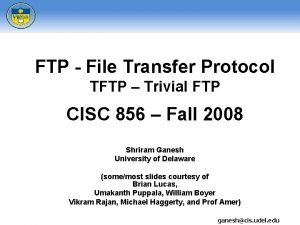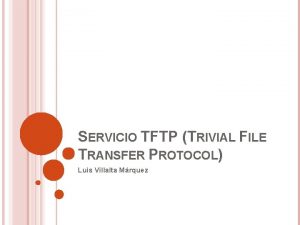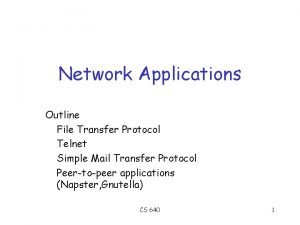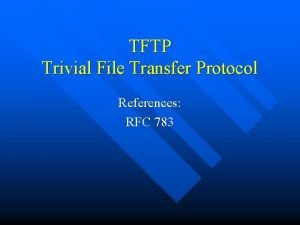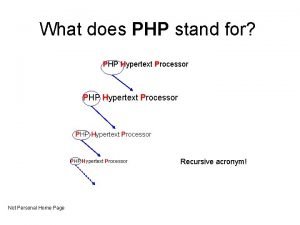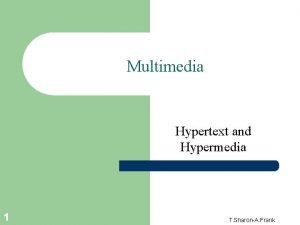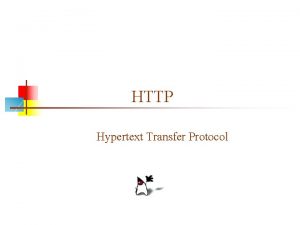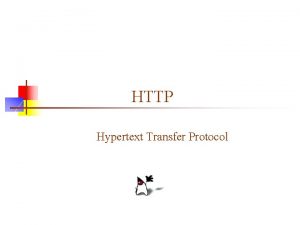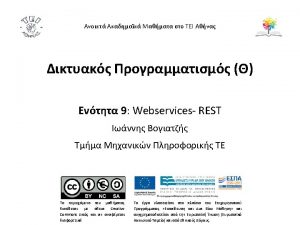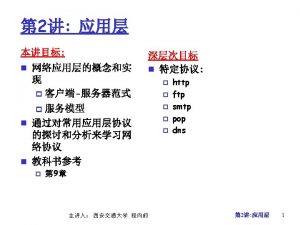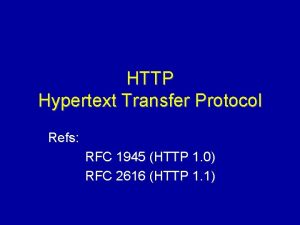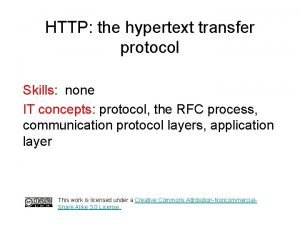HTTP Hypertext Transfer Protocol HTTP messages HTTP is















- Slides: 15

HTTP Hypertext Transfer Protocol

HTTP messages • HTTP is the language that web clients and web servers use to talk to each other – HTTP is largely “under the hood, ” but a basic understanding can be helpful • Each message, whether a request or a response, has three parts: 1. The request or the response line 2. A header section 3. The body of the message

What the client does, part I • The client sends a message to the server at a particular port (80 is the default) • The first part of the message is the request line, containing: – A method (HTTP command) such as GET or POST – A document address, and – An HTTP version number • Example: – GET /index. html HTTP/1. 0

Other methods • Other methods beside GET and POST are: – – HEAD: Like GET, but ask that only a header be returned PUT: Request to store the entity-body at the URI DELETE: Request removal of data at the URI LINK: Request header information be associated with a document on the server – UNLINK: Request to undo a LINK request – OPTIONS: Request information about communications options on the server – TRACE: Request that the entity-body be returned as received (used for debugging)

What the client does, part II • The second part of a request is optional header information, such as: – What the client software is – What formats it can accept • All information is in the form Name: Value • Example: User-Agent: Mozilla/2. 02 Gold (Win. NT; I) Accept: image/gif, image/jpeg, */* • A blank line ends the header

Client request headers • Accept: type/subtype, . . . – Specifies media types that the client prefers to accept • Accept-Language: en, fr, de – Preferred language (For example: English, French, German) • User-Agent: string – The browser or other client program sending the request • From: dave@acm. org – Email address of user of client program • Cookie: name=value – Information about a cookie for that URL – Multiple cookies can be separated by commas

What the client does, part III • The third part of a request (after the blank line) is the entity-body, which contains optional data – The entity-body part is used mostly by POST requests – The entity-body part is always empty for a GET request

What the server does, part I • The server response is also in three parts • The first part is the status line, which tells: – The HTTP version – A status code – A short description of what the status code means • Example: HTTP/1. 1 404 Not Found • Status codes are in groups: 100 -199 200 -299 300 -399 400 -499 500 -599 Informational The request was successful The request was redirected The request failed A server error occurred

Common status codes • 200 OK – Everything worked, here’s the data • 301 Moved Permanently – URI was moved, but here’s the new address for your records • 302 Moved temporarily – URL temporarily out of service, keep the old one but use this one for now • 400 Bad Request – There is a xyntax error in your request • 403 Forbidden – You can’t do this, and we won’t tell you why • 404 Not Found – No such document • 408 Request Time-out, 504 Gateway Time-out – Request took too long to fulfill for some reason

What the server does, part II • The second part of the response is header information, ended by a blank line • Example: • Content-Length: 2532 Connection: Close Server: GWS/2. 0 Date: Sun, 01 Dec 2002 21: 24: 50 GMT Content-Type: text/html Cache-control: private Set-Cookie: PREF=ID=05302 a 93093 ec 661: TM=1038777890: LM=1038777890: S= All on one line y. NWNjraft. Uz 299 RH; expires=Sun, 17 -Jan-2038 19: 14: 07 GMT; path=/; domain=. google. com There is a nice header viewer at http: //www. delorie. com/web/headers. html

Server response headers • Server: NCSA/1. 3 – Name and version of the server • Content-Type: type/subtype – Should be of a type and subtype specified by the client’s Accept header • Set-Cookie: name=value; options – Requests the client to store a cookie with the given name and value

What the server does, part III • The third part of a server response is the entity body • This is often an HTML page – But it can also be a jpeg, a gif, plain text, etc. --anything the browser (or other client) is prepared to accept

The <meta http-equiv> tag • The <meta http-equiv=string content=string> tag may occur in the <head> of an HTML document • http-equiv and content typically have the same kinds of values as in the HTTP header • This tag asks the client to pretend that the information actually occurred in the header – The information is not really in the header – As usual, not all browsers handle this information the same way • Example: <meta http-equiv="Set-Cookie" content="value=n; expires=date; path=url">

Summary • HTTP is a fairly straightforward protocol with a lot of possible kinds of predefined header information – • More kinds can be added, so long as client and server agree A request from the client consists of three parts: 1. A header line 2. A block of header information, ending with a blank line 3. The (optional) entity body, containing data • • • A response from the server consists of the same three parts HTTP headers are “under the hood” information, not normally displayed to the user As with most of the things covered in CIT 597, – – We have covered only the fundamentals Much more detail can be found on the Web

The End
 Udt protocol
Udt protocol Ftp vs tftp
Ftp vs tftp Ssh file transfer protocol rfc
Ssh file transfer protocol rfc Usenet message berenice
Usenet message berenice Tftp udp
Tftp udp File transfer protocol telnet
File transfer protocol telnet Rfc 783
Rfc 783 Purpose of ftp protocol
Purpose of ftp protocol Reliable data transfer protocol
Reliable data transfer protocol What php stands for?
What php stands for? Personal hypertext processor
Personal hypertext processor Hypertext and hypermedia in multimedia
Hypertext and hypermedia in multimedia Hypermedia vs hypertext
Hypermedia vs hypertext What is preprocessor in php
What is preprocessor in php Print media hypertext example
Print media hypertext example Definition of php
Definition of php

